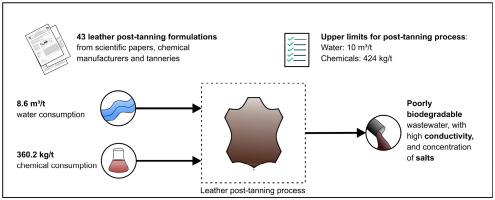Environmental Impact Assessment Review ( IF 9.8 ) Pub Date : 2021-04-20 , DOI: 10.1016/j.eiar.2021.106597 Éverton Hansen , Patrice Monteiro de Aquim , Mariliz Gutterres

|
The leather industry has significant consumption of water and chemicals and generates liquid effluents with a high pollution load. This study aims to contribute to the advance of liquid effluents, water, and chemicals management in tanneries since the assessment of these environmental issues for each step of the post-tanning process remains unknown. Forty-three post-tanning formulations were obtained from scientific papers, catalogs from chemical manufacturers and tanneries, and their data were analyzed. Results showed an average chemical consumption of 360.2 kg per ton of shaved leather. Retanning and fatliquoring steps are the largest chemical consumers. The average water demand of this process is 8.6 cubic meters per ton of shaved leather, with washing responsible for the highest consumption. The raw wastewater is poorly biodegradable, with high conductivity and elevated concentration of salts. The results obtained in this study contribute to reduce the environmental impacts of leather post-tanning, guiding future studies aiming to optimize this process.
中文翻译:

鞣制后皮革中的水,化学物质和废水的环境评估:综述
皮革工业消耗大量的水和化学物质,并产生高污染负荷的液体废水。这项研究旨在促进制革厂中液体废水,水和化学品管理的发展,因为对于制革后过程的每个步骤,这些环境问题的评估仍然未知。从科学论文,化学品制造商和制革厂的目录中获得了43种鞣后配方,并对其数据进行了分析。结果表明,每吨剃毛皮革平均化学消耗量为360.2千克。复鞣和加脂步骤是最大的化学消耗者。此过程的平均需水量为每吨剃毛皮革8.6立方米,其中洗水消耗量最大。原废水的生物降解性很差,具有高电导率和较高的盐浓度。这项研究中获得的结果有助于减少皮革鞣制后的环境影响,指导旨在优化该过程的未来研究。











































 京公网安备 11010802027423号
京公网安备 11010802027423号